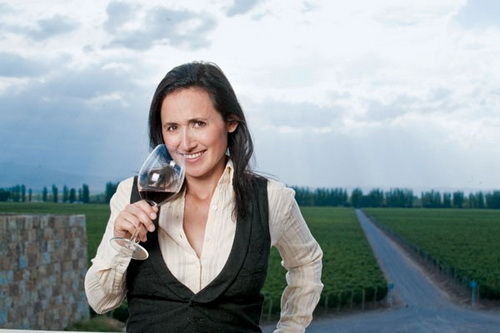 Continued from Part 3 of Argentine Wine
Continued from Part 3 of Argentine Wine
The Catena Alta Malbec Cabernet we’re drinking smolders in the glass. Its sultry edge is more enticing than the sweet, soupy international style of many brand name grapes.
Nicolás believes that drinkers are shifting away from the herbal flavors of Cabernet and turning more toward wines like Malbec (and Syrah, Tempranillo, and Grenache) that have fleshy dark red fruit and violet flavors.
Blending Malbec and Cabernet grapes is still traditional: “These blends give us French elegance and Latin passion,” as Nicolás explains.
However, he no longer believes that Malbec needs Cabernet Sauvignon—or any other grape—to make great wine.
Nicolás is aided in his research by his daughter, Laura, who also has both a scientific mind and a bent for commerce.
While she was pursuing her medical degrees at Harvard and Stanford universities, her father gave her a credit card.
“I told her that she could spend as much as she wanted, but it had to be on wine,” Nicolás says, a playful glint in his eyes.
Laura now divides her time between San Francisco where she, her husband and three young children live and where she works as an emergency room doctor—and Argentina, where she’s export director for the winery.
She’s conducting fifteen hundred experiments on different variables that contribute to wine quality, such as vine exposure to the sun, pruning at different times of the year, irrigation methods and fermentation temperatures.
Every season, she applies the successful methods to next year’s vintage and adds more variables.
 Laura and her father believe that there is no one optimum moment in the vineyard as other producers do; rather there are many captured in the glass by harvesting the grapes as many as eight different times.
Laura and her father believe that there is no one optimum moment in the vineyard as other producers do; rather there are many captured in the glass by harvesting the grapes as many as eight different times.
Their view is that one harvest with one vinification (fermentation) is a one-dimensional wine, which is why they have more than three thousand separate vinifications.
That may sound iconoclastic, but as Nicolás observes, “We can innovate because the consumer has no history for us: we are creating that now.
The French have a 500-year lead on us, but every year, we jump a decade in learning.”
Argentina may be new in consumer memory, but it has a long history of winemaking. It’s another country that doesn’t fit neatly into either the Old World or New World categories, but is more Middle Earth.
In 1541, Spanish conquistadors in search of silver (the Latin “argentum” after which the country is named) planted Tempranillo grapes in here to make wine for religious services (and for thirsty invaders).
For three centuries, that rough local wine was the only kind produced here until the nineteenth century, following Argentina’s independence from Spain, when a flood of immigrants began to arrive from Spain, Italy, and France.
Most were farmers and they brought with them treasured vine cuttings from the old country: Spanish Tempranillo and Torrontés, Italian Barbera and Sangiovese, and French Cabernet Sauvignon, Viognier and Malbec.
However, things started to go downhill for the wine industry throughout the twentieth century, thanks to a variety of basket-case economic and political policies.
But it was president Juan Péron who really sent wine consumption into decline when he imposed high domestic taxes in the 1950s. (Someone had to pay for his lavish lifestyle with Evita.)
Read Part 5 Malbec Wine …









